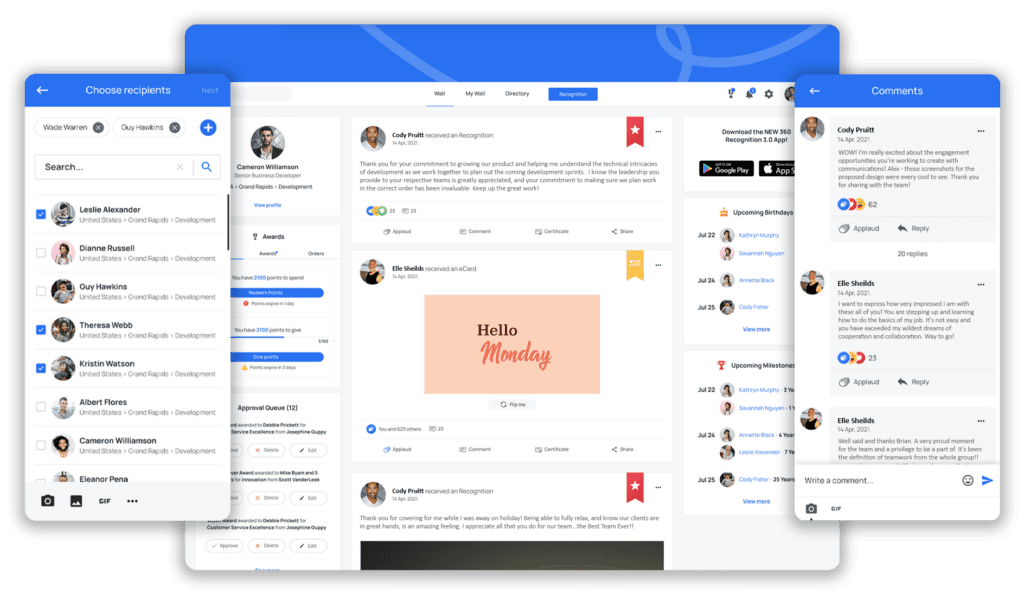February 12, 2024

Failed incentive programs waste your company's time, money, resources, and trust. Fortunately, they're not a spontaneous, random occurrence that strikes businesses at will—they're often the result of a few common pitfalls.
Incentive programs are supposed to incentivize employee motivation and productivity while providing a big "thank you" from the business. However, not every incentive hits the mark. Sometimes, despite the best plans, these programs don't quite deliver the punch they were meant to.
But why do some employee incentive programs fail and others don't?
Creating incentive plans that actually motivate employees is more art than science. It's about understanding what makes your team tick and crafting something that speaks to them. This is where a lot of programs miss the mark. They're either too generic, too complicated, or just out of sync with what employees really value and employees then lose interest.
We're here to help you avoid another failed incentive program. We know a thing or two about employee recognition programs (it's kind of our thing), and we'll walk you through everything you need to know to create successful incentive programs that boost employee morale and productivity.
What Is an Incentive Program?
Incentive programs are a collection of the strategies and tactics you use to encourage and reward top-notch performance from your employees. Oftentimes, incentive plans are designed for sales personnel, green initiatives, and safety objectives, depending on company goals.
The goal is to boost morale and organizational performance, improve productivity, and motivate people to go above and beyond (knowing there's something in it for them, too).
Incentive programs come in all shapes and sizes, but here are some of the most common types:
- Monetary Rewards: The classic cash bonus. It's straightforward, measurable, and, let's face it, who doesn't like a little extra in their paycheck?
- Recognition and Rewards Programs: These are the shout-outs for a job well done, often in front of peers. They can be formal, like Employee of the Month awards, or more casual, like a quick thank-you note.
- Professional Development Opportunities: Consider these as investments in your team's future. Offering training, workshops, or courses to help employees grow their skills and careers.
- Experiences and Perks: Sometimes, it's not about the money or the plaque on the wall. Things like extra vacation days, exclusive events, or even a prime parking spot can make employees feel special and valued.
Need some inspiration to get you started? Take a look at our favorite employee incentive program ideas to motivate your teams.
Incentive Programs' Role in Employee Engagement
Are incentive schemes worth all the time, money, and research? When executed correctly, yes. Undoubtedly, yes.
Employee engagement is the heartbeat of any successful business. People who feel motivated and loyal to their company lead to better outcomes for the company and the culture. And here's where the magic of incentive and rewards programs comes into play.
Well-designed incentive programs speak directly to the psychological needs of employees and reinforce certain behaviors. According to motivation theories like Maslow's hierarchy of needs and Herzberg's two-factor theory, people aren't just driven by money (shocking, right?).
Instead, people tend to want:
- Recognition
- A sense of belonging
- Achievement
- Equity
- Opportunities for growth
For example, employee recognition programs that celebrate individual and team achievements can fulfill the need for esteem and belonging. On the other hand, talent development opportunities address the desire for self-actualization by helping employees reach their full potential.
When incentive programs are thoughtfully designed with the psychological needs of employees in mind, they can transform the workplace. Employees feel more connected, valued, and driven—ready to contribute their best to the team's success. And that's a win-win for everyone.
How to Spot a Failed Incentive Program
The only thing worse than a failed incentive plan is a failed program you don't even recognize is failing. Fortunately, there are a handful of tell-tell signs your program might be missing the mark or falling flat:
- Lack of Employee Engagement: Your employees don't engage with the program or show any interest in participating.
- High Turnover Rates: If you're seeing a lot of turnover (or difficult talent acquisition), especially among your rockstar employees, it could be a sign that your incentive program isn't doing its job of keeping people happy and motivated.
- Minimal Impact on Performance: If you're not seeing any noticeable improvements in performance metrics or outcomes, it might be time to reevaluate your approach.
- Negative Feedback: Your employees are your best source of feedback, and if they're grumbling about the program being confusing, unfair, or ineffective, you should take notes.
- Discrepancies in Distribution: Fairness is key when it comes to incentives. If certain employees seem to be raking in rewards while others are left empty-handed, it could be a sign of trouble brewing.
- Decline in Morale: A successful incentive program should lift spirits and bring teams together. However, if you're noticing a drop in morale or a breakdown in teamwork, it might be a sign that your program is having unintended consequences.
Commons Pitfalls of Incentive Programs
Creating an incentive program can feel like walking a tightrope. Even a slight misstep could hurt employee engagement and morale and waste valuable time and resources.
If you're going to create an incentive program, go all in. Half-hearted measures often do more harm than good. So, when you take the leap, jump with both feet.
While your intentions for creating an incentive program might be noble, several pitfalls can derail your plans. Let's explore these surprises and how you can avoid them.
1. Lack of Clear Objectives
Employees need to know what they're working towards and how their efforts will be rewarded. When objectives are vague or non-existent, it leaves employees feeling lost and demotivated.
- Clearly define the objectives of your incentive plans, including specific goals, metrics, and desired outcomes.
- Hold regular meetings or communications to ensure everyone understands the objectives and how their efforts contribute to achieving them.
- Before launching the program, gather input from key stakeholders to ensure objectives are aligned with organizational goals and employee needs.
2. Poor Communication
Whether it's unclear program guidelines, inconsistent messaging, or lack of feedback, communication breakdowns can lead to confusion and frustration among participants.
- Establish clear communication channels for program guidelines, updates, and feedback.
- Implement regular check-ins or pulse surveys to gather participant feedback and address any communication gaps or misunderstandings.
- Provide training or resources to managers and leaders on effective communication strategies to maintain consistent messaging throughout the organization.
RELATED: What is an Employee Engagement Survey? And Why Should You Care?
3. One-Size-Fits-All Approach
People are unique, with different motivations, preferences, and goals. Yet, many incentive programs take a one-size-fits-all approach, offering everyone the same rewards and incentives. This cookie-cutter approach fails to acknowledge the diverse needs of employees and can result in disengagement and resentment.
- Conduct surveys or focus groups to understand employee preferences and incorporate their input into program design.
- Tailor incentive programs to meet the diverse needs and preferences of employees.
- Offer customizable options or tiered rewards to accommodate different motivational drivers.

4. Inadequate Measurement and Feedback
Without proper measurement and feedback mechanisms in place, incentive programs are flying blind. How can you know if the program is effective if you're not tracking progress or collecting feedback from participants?
Inadequate measurement and feedback leave organizations in the dark about what's working and what's not, making it impossible to make informed decisions and improvements.
- Prioritize investment in technology or resources that enable robust measurement and feedback mechanisms from the outset.
- Regularly review program metrics and participant feedback to identify areas for improvement.
- Tie your measurement factors to your objectives—you should measure what matters.
5. Misaligned Rewards
When rewards don't align with employee values or organizational culture, they can do more harm than good. For example, offering a cash bonus for a team that values work-life balance over financial rewards may lead to dissatisfaction and disengagement.
- Solicit employee input on reward preferences and use data analytics to identify trends and patterns in reward effectiveness.
- Align rewards with employee values, preferences, and organizational culture.
- Regularly review reward structures to ensure they remain relevant and meaningful to employees.
6. Lack of Employee Involvement
The best incentive programs are created by employees for employees. When programs are imposed from the top down without input from those they affect, it can breed employee resentment and disengagement.
- Involve employees in the design and implementation of incentive programs.
- Create a work culture of transparency and collaboration where employees feel empowered to share their ideas and opinions on incentive programs.
- Establish employee committees or focus groups to provide input and feedback on program design.
7. Insufficient Resources
Even the best-laid incentive plan can fall flat without adequate resources. Whether it's budget constraints, lack of time, or insufficient support from leadership, inadequate resources can doom incentive programs from the start.
- Involve stakeholders from finance and human resources departments in program planning to ensure an adequate recognition budget and resource allocation.
- Conduct a thorough assessment of resource needs before launching the program.
- Advocate for additional resources or reallocate existing resources to support the program's success.
8. Misalignment of Intrinsic and Extrinsic Motivation
Solely on extrinsic rewards like bonuses and perks may provide short-term motivation, but it's unlikely to sustain long-term engagement. Organizations that neglect intrinsic motivators like autonomy, mastery, and purpose risk missing out on deeper levels of employee engagement and satisfaction.
- Educate leaders and managers on balancing extrinsic and intrinsic motivators in driving long-term employee satisfaction and engagement.
- Incorporate intrinsic motivation such as recognition, autonomy, and opportunities for growth into the incentive program.
- Offer non-monetary rewards or recognition programs that emphasize the value of employee contributions beyond financial incentives.
9. Inflexibility
Organizations and their workforce are constantly evolving, and what motivates employees today may not be the same tomorrow. Incentive programs that fail to adapt to changing needs, preferences, and priorities may become outdated and lose effectiveness over time.
- Anticipate future changes and trends in the workforce when designing incentive programs to ensure they remain relevant and effective over time.
- Regularly review and update incentive program offerings based on evolving employee feedback and organizational objectives.
- Build flexibility into incentive program structures to accommodate changing needs and priorities.
10. Delayed Timelines
Delayed or infrequent recognition can diminish its impact. Research suggests that employees who receive credit long after their achievements may feel undervalued or overlooked. Additionally, failing to provide timely feedback can hinder employees' ability to course-correct or improve their performance.
"Effective recognition is not a once-a-year event. It's a continuous process that should be woven into the fabric of your organization's culture." — Cindy Ventrice, author of "Make Their Day! Employee Recognition That Works"
- Establish clear timelines and processes for recognizing and rewarding employee achievements.
- Set up automated reminders or notifications to prompt managers and leaders to provide timely feedback and recognition to employees.
- Implement real-time or immediate recognition platforms to ensure timely acknowledgment of employee contributions.

11. Inconsistencies
When rules, criteria, or rewards are applied inconsistently across teams or individuals, it can breed resentment and create perceptions of favoritism or unfair treatment.
- Develop standardized guidelines and criteria for applying rewards consistently across teams and individuals.
- Regularly audit program implementation to identify and address any instances of inconsistency or bias in reward distribution.
- Provide training and resources to managers on fair and equitable distribution of rewards and recognition.
12. Missing Small Wins
It's not just the biggest or loudest accomplishments that should be recognized. Overlooking small wins and achievements can lead to missed opportunities to reinforce positive behaviors and maintain momentum.
- Recognize and celebrate small wins and milestones along the way, even if they may seem minor. Every step towards a larger goal deserves recognition.
- Foster a culture where managers and peers actively acknowledge and appreciate the contributions and achievements of team members, no matter how small.
- Implement rewards and incentives for achieving small wins to provide additional motivation and recognition for employees' efforts.
13. Underwhelming Benefits
Employees may find your incentive scheme to be lacking or uninspiring. If you expect them to go above and beyond their duties, the reward should match (or exceed) their investment.
For example, your employees might be more interested in a Kindle than a traditional tablet. Or they might value tickets to a concert rather than lunch with an executive.
Yes, it'll require more research and investment on your part, but that's what's necessary to get your employees to do the same.
- Provide benefits that hold significant value to employees, such as opportunities for professional development, flexible work arrangements, or personalized rewards.
- Gather employee feedback to understand their preferences and expectations regarding incentive program benefits.
- Continuously assess and update the benefits offered through the incentive program to ensure they remain relevant and appealing to employees.

Real-Life Examples of Successful Incentive Programs
Inspiration often comes from seeing real-world success stories. While you shouldn't copy and paste any other company's incentive program, they can help you brainstorm ideas for your own culture and employees.
Here are a few of our favorite real-life examples of successful incentive programs. From industry giants to innovative startups, these organizations have implemented creative and effective strategies to motivate, reward, and retain their workforce:
- Zappos: Zappos, the online shoe and clothing retailer, is renowned for its innovative approach to employee incentives. They offer perks such as free lunches, onsite fitness classes, and even a nap room to promote employee well-being and job satisfaction.
- Bain and Company: Bain and Company, a global management consulting firm, is known for its employee-centric culture. They offer a range of incentives, including performance bonuses, recognition programs, and professional development opportunities, to reward and motivate their employees.
- Ultimate Software: Ultimate Software, a leading provider of people-management software, treats its employees to a free vacation every two years as a reward for their hard work and dedication.
- Hilcorp Energy Company: Hilcorp Energy Company promised its staff a $100,000 check if the company doubled its production rate and reserves by a specific deadline. This bold incentive motivated employees to work towards a common goal and achieve exceptional results.
- Salesforce: Salesforce, a leading cloud-based software company, is known for its generous compensation packages and employee benefits. The company offers competitive salaries, performance bonuses, stock options, and comprehensive healthcare coverage to attract and retain top talent.
- Google: Google is famous for its employee perks and benefits, which include onsite wellness and fitness centers, free gourmet meals, and generous parental leave policies. The company also offers opportunities for professional development and career advancement through internal training programs and tuition reimbursement.
- Southwest Airlines: Southwest Airlines has a unique employee incentive program called "ProfitSharing." Through this program, employees receive a portion of the company's profits based on their years of service and compensation level. This incentive encourages employees to work together towards the company's success and share its financial rewards.
- Patagonia: Patagonia, an outdoor clothing and gear company, offers its employees paid time off to participate in environmental activism and volunteer work. The company's commitment to environmental sustainability and social responsibility is reflected in its employee incentive programs, fostering a sense of purpose and engagement among staff members.
How to Avoid Incentive Programs Failing in the Long Run
Creating an incentive program isn't just a one-and-done deal. It's something you'll need to tend to, nurture, and sometimes, even give a little extra love to keep it thriving.
Here are some tips to make sure your program stays fresh and compelling for the long haul:
Make Recognition Part of Your Culture
Recognition is a key ingredient in any incentive program's recipe. It's the secret sauce that keeps it fresh and inviting.
It's not just about formal awards or bonuses (although those are important, too)—it's about giving props to your team whenever they knock it out of the park. Encourage high-fives, shout-outs, and virtual fist bumps to keep morale and motivation soaring.
Consider implementing social recognition software that allows employees to recognize each other anywhere, at any time.
Don't Be Afraid to Shake Things Up
Your incentive program needs a refresh every now and then. Take a look at what's working, what's not, and what could use a little extra oomph. Then, mix things up with new challenges, rewards, or incentives to keep your team engaged and excited.
Equip Your Teams for Success
Offer training and support to help your managers effectively communicate program goals, provide meaningful feedback, and keep the momentum strong.
Let Your Team Lead the Way
Your employees know what makes them tick better than anyone else. Don't be afraid to ask for their input and ideas. Create channels for feedback and involvement to ensure your program stays relevant, engaging, and tailored to the needs of your team.
Keep Your Finger on the Pulse
Keep a close eye on your program metrics to see how things are shaping up. Monitor participation rates, feedback, and results to identify areas for improvement and fine-tune your approach for maximum impact.
Party Like It's 1999 (or Any Other Year)
Feel free to break out the confetti and celebrate when your team hits a milestone or achieves a big win. Whether it's a virtual dance party, a team lunch, or a shoutout in the company newsletter, take the time to recognize and celebrate your team's hard work and achievements.

Create Successful Incentive Programs with Terryberry
Now that you know what a failed incentive program looks like, it's time to build, fix, and adapt your program for short-term and long-term success. At Terryberry, we're passionate about helping organizations like yours create engaging, effective, and downright awesome incentive programs that keep your team motivated, inspired, and ready to conquer the world.
Our customizable solutions and expert guidance help you:
- Design an incentive system tailored to your unique needs and objectives
- Foster a culture of recognition and appreciation that keeps your team fired up
- Leverage cutting-edge technology to streamline program management and tracking
- Stay ahead of the curve with ongoing support, training, and program optimization
Don't settle for a lackluster program that leaves your team feeling uninspired. Partner with Terryberry and unleash the full potential of your incentive initiatives. Get in touch today, and let's start building something incredible together.




